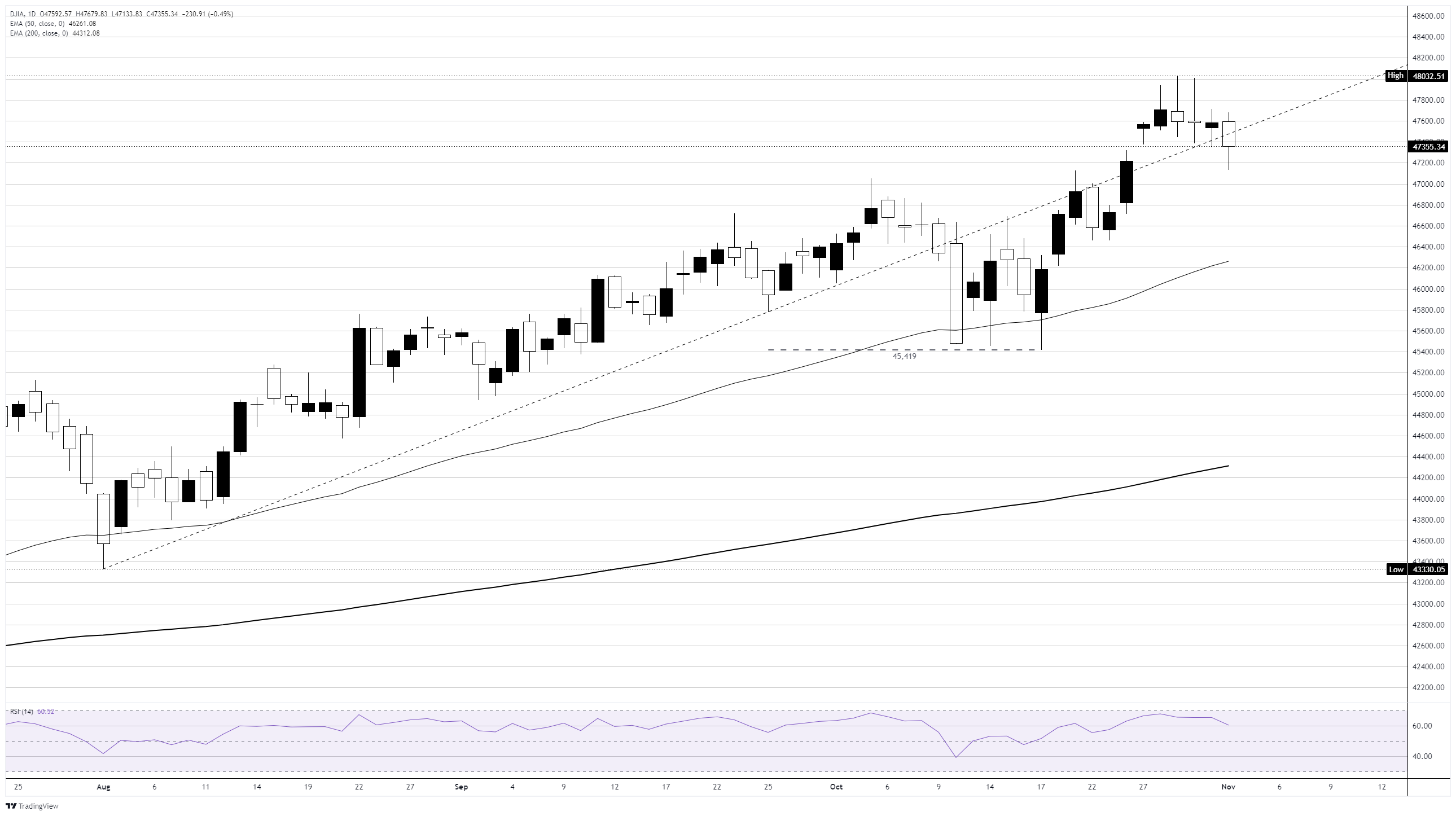Dow Jones Industrial Average misses out on Mag 7 gains

- The Dow Jones eased back below 47,500 on Monday, though losses remain limited.
- Equity markets are overall higher to start the new trading week as Mag 7 investment roulette continues.
- ISM PMI data showed a slight easing in business sentiment, but the index remains within normal levels.
The Dow Jones Industrial Average (DJIA) faced fresh declines on Monday, kicking off the new trading week with a 200-point decline. The Dow briefly tested below the 47,250 level for the first time in over a week, as 'Magnificent 7' concentrated investment gains lift other indexes.
Amazon (AMZN) saw a fresh rally on Monday, climbing around 5% after the internet ownership and baubles shipping giant announced a deal to invest $38 billion in ChatGPT maker OpenAI. Iren (IREN) data center supplier also inked its own $9.7 billion deal with Microsoft to provide additional hardware architecture to meet the ever-growing LLM tech growth demand. At the top of the pile, the lone chipmaker giant at the top of the AI tech mountain Nvidia (NVDA) climbed 3.7% as both of the AI investment deals announced on Monday will involve providing access to Nvidia hardware.
ISM PMIs show businesses still struggling with cautious buyers
The latest Institute for Supply Management (ISM) Purchasing Managers Index (PMI) report dipped to 48.7 in October, missing expectations and falling back slightly from September’s 49.1. Demand indicators within the ISM report broadly improved over the month, however all still remain in contraction territory, implying businesses are struggling to find new customers or convince current clients to expand operations. Overall, manufacturing activity among businesses that bothered to submit responses to surveys showed a net decline in economic activity in the manufacturing sector for an eighth straight month.
The Federal Reserve’s (Fed) speech patterns have taken a hard left turn as of late, veering into a more chaotic presentation than usual as policymakers’ opinions begin to deviate from a carefully crafted consensus. Investors have grown used to a certain level of organized pageantry from Federal Reserve talking points, but a brave new world has opened up before markets based on Fed Chair Jerome Powell’s surprisingly cautious stance at the Fed’s latest rate call. Fed officials also gave a rare three-way vote last week, with a few flyaway voters advocating for even steeper rate cuts or no cuts at all.
The shifting stance within the Fed has thrown market expectations for a December interest rate cut into jeopardy. According to the CME’s FedWatch tool, rate traders are still pricing in over 65% odds that the Fed will deliver a third straight interest rate cut on December 10; however, the majority of rate market bettors see even greater odds that the Fed will be pushed into waiting until January to deliver another 25 basis point rate cut.
Dow Jones daily chart

Dow Jones FAQs
The Dow Jones Industrial Average, one of the oldest stock market indices in the world, is compiled of the 30 most traded stocks in the US. The index is price-weighted rather than weighted by capitalization. It is calculated by summing the prices of the constituent stocks and dividing them by a factor, currently 0.152. The index was founded by Charles Dow, who also founded the Wall Street Journal. In later years it has been criticized for not being broadly representative enough because it only tracks 30 conglomerates, unlike broader indices such as the S&P 500.
Many different factors drive the Dow Jones Industrial Average (DJIA). The aggregate performance of the component companies revealed in quarterly company earnings reports is the main one. US and global macroeconomic data also contributes as it impacts on investor sentiment. The level of interest rates, set by the Federal Reserve (Fed), also influences the DJIA as it affects the cost of credit, on which many corporations are heavily reliant. Therefore, inflation can be a major driver as well as other metrics which impact the Fed decisions.
Dow Theory is a method for identifying the primary trend of the stock market developed by Charles Dow. A key step is to compare the direction of the Dow Jones Industrial Average (DJIA) and the Dow Jones Transportation Average (DJTA) and only follow trends where both are moving in the same direction. Volume is a confirmatory criteria. The theory uses elements of peak and trough analysis. Dow’s theory posits three trend phases: accumulation, when smart money starts buying or selling; public participation, when the wider public joins in; and distribution, when the smart money exits.
There are a number of ways to trade the DJIA. One is to use ETFs which allow investors to trade the DJIA as a single security, rather than having to buy shares in all 30 constituent companies. A leading example is the SPDR Dow Jones Industrial Average ETF (DIA). DJIA futures contracts enable traders to speculate on the future value of the index and Options provide the right, but not the obligation, to buy or sell the index at a predetermined price in the future. Mutual funds enable investors to buy a share of a diversified portfolio of DJIA stocks thus providing exposure to the overall index.







